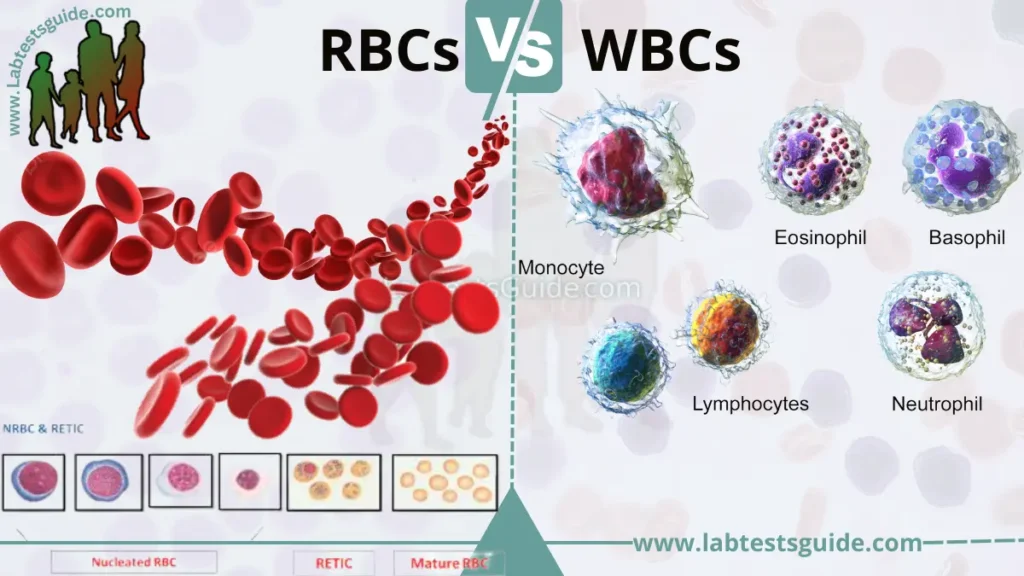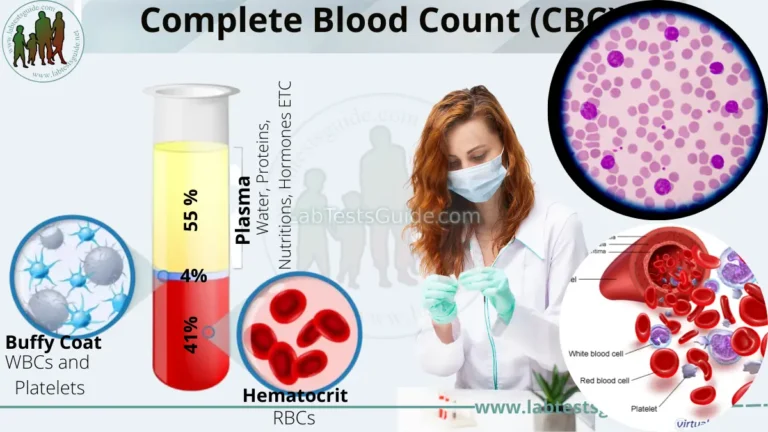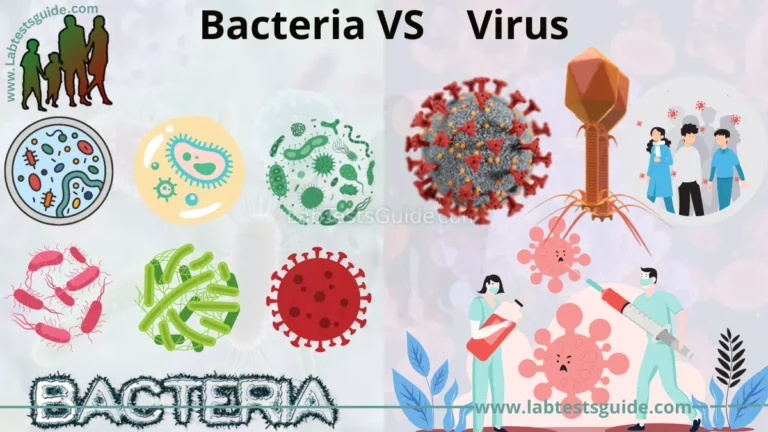Differences Between RBCs and WBCs: Red blood cells (RBCs) and white blood cells (WBCs) are both types of blood cells but differ in their functions and physical characteristics. RBCs, also called erythrocytes, are responsible for carrying oxygen to the body’s tissues and removing carbon dioxide. They are small, biconcave in shape, and contain hemoglobin, a protein that binds to oxygen. On the other hand, WBCs, also called leukocytes, are part of the body’s immune system and help fight infections and diseases. They are larger than RBCs, have a nucleus, and are classified into different types based on their functions. Unlike RBCs, WBCs can leave the bloodstream and enter tissues to fight infections.

Definations:
Defination of RBCs:
Red blood cells (RBCs), also known as erythrocytes, are specialized cells in the blood that are responsible for carrying oxygen from the lungs to the body’s tissues and transporting carbon dioxide back to the lungs for removal. RBCs are disc-shaped and contain the protein hemoglobin, which binds to oxygen and gives them their characteristic red color. RBCs do not have a nucleus or other organelles, allowing them to be more efficient at carrying oxygen. They are produced in the bone marrow and have a lifespan of approximately 120 days before being broken down and recycled by the body.
Defination of WBCs:
White blood cells (WBCs), also known as leukocytes, are a type of blood cell that plays a critical role in the body’s immune system. WBCs help to protect the body against infection and disease by detecting and destroying invading pathogens such as viruses, bacteria, and fungi. There are different types of WBCs, including neutrophils, lymphocytes, monocytes, eosinophils, and basophils, each with its own specialized function. Unlike red blood cells, WBCs have a nucleus and can leave the bloodstream to enter tissues and fight infections. They are produced in the bone marrow and lymphatic tissues and can be affected by a variety of factors, including infections, medications, and medical conditions.
Differences Between RBCs and WBCs:
There are several differences between red blood cells (RBCs) and white blood cells (WBCs):
- Function: RBCs are responsible for carrying oxygen to the body’s tissues and removing carbon dioxide, while WBCs are part of the immune system and help fight infections and diseases.
- Shape: RBCs are small and biconcave in shape, while WBCs are larger and have a spherical or irregular shape.
- Nucleus: RBCs do not have a nucleus, while most WBCs have a nucleus and other organelles.
- Hemoglobin: RBCs contain hemoglobin, a protein that binds to oxygen, while WBCs do not contain hemoglobin.
- Lifespan: RBCs have a lifespan of approximately 120 days, while WBCs have a much shorter lifespan, ranging from a few hours to a few days.
- Production: RBCs are produced in the bone marrow, while WBCs are produced in the bone marrow and lymphatic tissues.
- Functionality: RBCs are primarily involved in gas exchange, while WBCs are primarily involved in immune response.
- Number: RBCs are much more numerous than WBCs in the bloodstream, with a ratio of approximately 700:1.
- RBCs are not capable of dividing, while WBCs can undergo mitosis to produce more cells.
- RBCs do not have the ability to leave the bloodstream, while WBCs can move out of the bloodstream and into tissues to fight infections.
Table of Differences:
Here is a table summarizing the differences between red blood cells (RBCs) and white blood cells (WBCs):
| Characteristic | RBCs | WBCs |
|---|---|---|
| Function | Carry oxygen and remove carbon dioxide | Fight infections and diseases |
| Shape | Small and biconcave | Larger and spherical/irregular |
| Nucleus | None | Present (except in mature red blood cells) |
| Hemoglobin | Present | Not present |
| Lifespan | Approximately 120 days | Shorter lifespan, ranging from a few hours to a few days |
| Production | Bone marrow | Bone marrow and lymphatic tissues |
| Functionality | Gas exchange | Immune response |
| Number | More numerous, with a ratio of approximately 700:1 | Less numerous |
| Division | Not capable of dividing | Can undergo mitosis to produce more cells |
| Migration | Cannot leave bloodstream | Can leave bloodstream and move into tissues to fight infections |
Similarities Between RBCs and WEBs:
Despite their many differences, there are some similarities between red blood cells (RBCs) and white blood cells (WBCs):
- Both are types of blood cells that are produced in the bone marrow.
- Both play important roles in maintaining the body’s overall health and functioning.
- Both are involved in the transportation of substances within the body – RBCs carry oxygen and carbon dioxide, while WBCs help to transport nutrients, hormones, and waste products.
- Both are affected by a variety of factors, including infections, medical conditions, and certain medications.
- Both can be analyzed through blood tests to assess overall health and diagnose certain medical conditions.
Table of Similarities:
Here is a table summarizing the similarities between red blood cells (RBCs) and white blood cells (WBCs):
| Characteristic | RBCs | WBCs |
|---|---|---|
| Production | Produced in the bone marrow | Produced in the bone marrow |
| Importance | Play important roles in maintaining overall health and functioning | Play important roles in maintaining overall health and functioning |
| Transportation | Involved in the transportation of substances within the body | Involved in the transportation of substances within the body |
| Factors Affecting | Affected by infections, medical conditions, and certain medications | Affected by infections, medical conditions, and certain medications |
| Analyzation | Can be analyzed through blood tests | Can be analyzed through blood tests |
FAQs (Frequently Asked Questions ):
What are red blood cells?
A: Red blood cells, also known as erythrocytes, are the most common type of blood cell in the body and are responsible for carrying oxygen to the body’s tissues and removing carbon dioxide.
What are white blood cells?
A: White blood cells, also known as leukocytes, are part of the immune system and help fight infections and diseases.
What is the function of red blood cells?
A: The main function of red blood cells is to carry oxygen to the body’s tissues and remove carbon dioxide.
What is the function of white blood cells?
A: The main function of white blood cells is to fight infections and diseases.
What is the lifespan of red blood cells?
A: The lifespan of red blood cells is approximately 120 days.
What is the lifespan of white blood cells?
A: The lifespan of white blood cells ranges from a few hours to a few days.
What is hemoglobin?
A: Hemoglobin is a protein found in red blood cells that binds to oxygen and helps transport it throughout the body.
How are red blood cells produced?
A: Red blood cells are produced in the bone marrow.
How are white blood cells produced?
A: White blood cells are produced in the bone marrow and lymphatic tissues.
Can red blood cells divide?
A: No, red blood cells cannot divide.
Can white blood cells divide?
A: Yes, white blood cells can undergo mitosis to produce more cells.
How are red blood cells destroyed?
A: Red blood cells are destroyed by the spleen and liver.
How do white blood cells fight infections?
A: White blood cells identify and attack foreign invaders such as bacteria, viruses, and parasites.
How many types of white blood cells are there?
A: There are five types of white blood cells: neutrophils, lymphocytes, monocytes, eosinophils, and basophils.
What is the ratio of red blood cells to white blood cells in the bloodstream?
A: The ratio of red blood cells to white blood cells in the bloodstream is approximately 700:1.
Can red blood cells leave the bloodstream?
A: No, red blood cells cannot leave the bloodstream.
Can white blood cells leave the bloodstream?
A: Yes, white blood cells can leave the bloodstream and move into tissues to fight infections.
What factors can affect red blood cells?
A: Infections, medical conditions, and certain medications can affect red blood cells.
What factors can affect white blood cells?
A: Infections, medical conditions, and certain medications can affect white blood cells.
How are blood cells analyzed?
A: Blood cells can be analyzed through blood tests, which can assess overall health and diagnose certain medical conditions.
Conclusion:
In conclusion, red blood cells (RBCs) and white blood cells (WBCs) are both important types of blood cells that play vital roles in maintaining the body’s overall health and functioning. While they have many differences in terms of their structure, function, and lifespan, they also share some similarities, such as their production in the bone marrow and their involvement in the transportation of substances within the body. Understanding the roles and characteristics of RBCs and WBCs is crucial for maintaining optimal health and preventing and treating a variety of medical conditions.
Possible References Used







